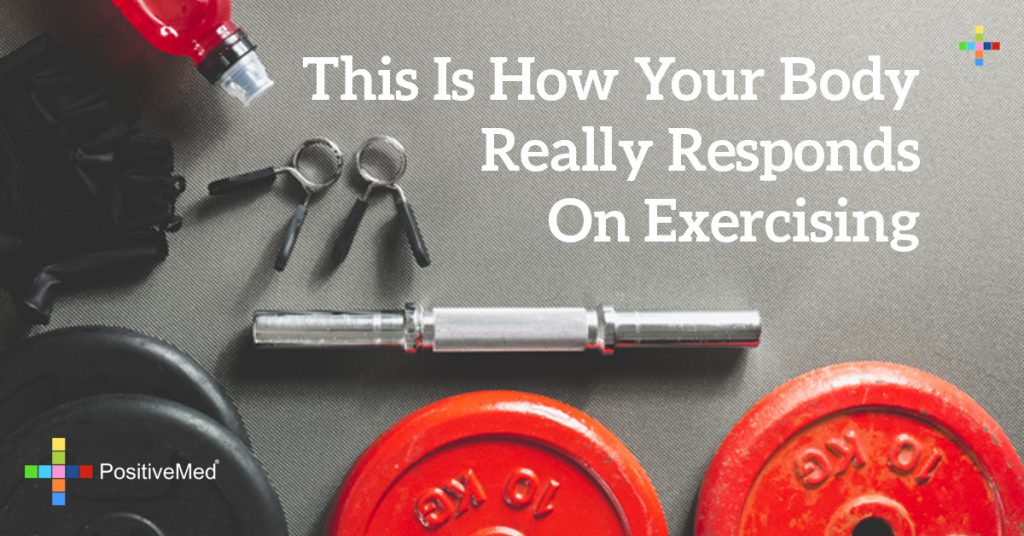
This is How Your Body Really Responds on Exercising
[nextpage title=”…”]
Pharmaceutical miracles abound in the United States. Medicine holds diabetes 2 in check, manages heart problems, fights cancer and keeps the colon open. What if I told you there is a do-it-yourself medication available to all? You would probably refuse my offer. After all, non-prescription drugs may be illegal!

This medication is pushed, literally pumped, every day by people who know the benefits.
It’s called exercise. Exercise doesn’t just address symptoms, it changes the entire body from top to bottom.
Let’s start with the brain on top. Brain cells begin functioning at warp speed and alertness as blood flow increases with exercise. That’s good news for older people at risk for dementia. According to the Alzheimer’s Research and Prevention Foundation, regular work-outs lower the risk of this terrible disease by 50 percent!
With a brisk walk, endorphins flood the brain, increasing seratonin and elevating the mood. Exercise is proven to assist with depression, a precursor of other unfortunate mental conditions. The hippocampus begins manufacturing new cells, which facilitate memory and learning. The pituitary gland releases growth hormones, so essential for resilience, youth and beauty.
Huffing and puffing is great! This stimulates oxygen use through the lungs called VO2 max. When you reach VO2 max, you crash. You can’t rev up any higher. The higher the VO2 max, the better condition the person is in.
Within the lungs lies the heart. Exercise increases the heart rate, forcing the body to circulate more blood oxygenated by the lungs. The heart gains efficiency through practice, through consistent workouts. Very fit people have such a muscular, efficient heart that their resting pulse rate is very low. New vessels are formed in the same way, lowering blood pressure in well-conditioned people.
No one thinks of the stomach’s functions being changed by exercise, because most of us just want it to look flatter. During exercise, stomach function is diminished. It takes plenty of blood flow to digest food, and blood flow is necessarily directed to muscles during exercise, which is why it may be better to wait to visit the gym after a meal. On the other hand, exercise tends to speed the colon right along. Exercise and fiber-laden whole foods generally eliminate the need for laxatives.
RELATED ARTICLE: NO EQUIPMENT EXERCISES: THE NATURAL WAY TO GET GREAT HAMSTRINGS
[/nextpage] [nextpage title=”…”]
Skin products are a multi-million dollar industry. All of us want to look younger, fresher, more beautiful. Exercise pumps blood to the face, widening capillaries and clearing pores. The body, just like an engine, produces more heat when revved up. This heat dissipates through the skin through blood flow.
People who exercise regularly tend to have smoother, fresher-looking complexions. According to The Daily Mail, even people who began exercising later in life were observed to have younger-looking skin.
Researchers at McMaster University in Ontario took a look at mice, first. They noted that mice allowed exercise wheels had lush fur with youthful color. When the wheel exercise was eliminated, older mice quickly became bald and gray. People, when compared, exemplified the same principle. The ones who exercised showed significantly younger, firmer skin.
The liver probably got its name for good reasons. No one lives without one.
Aerobic exercise increases blood flow and allows the liver to filter and send blood with ease. Weight training prevents the excess body fat bringing on a fatty liver, eventually causing it to become dysfunctional. This is called non-alcoholic steatohepatitis, or NASH. Many Americans today are obese, exhibiting the large, fatty stomachs indicative of later liver dysfunction. The medication to prevent NASH is exercise.
RELATED ARTICLE: Top 10 Exercises To Heat Your Regular Workout
Muscles are the first thing we think of in connection with exercise, and rightly so. Muscles make exercise possible, and they benefit greatly from consistent workouts. At first, muscle aches and pains cause discomfort with exercise when a person is not fit. But this is the result of tiny tears forming in the muscles that actually stimulate them to grow and get stronger. Muscle building is especially beneficial for older people. Exercise and the building of muscle prevents bone loss and lubricates joints and tendons. Muscle mass prevents the injuries so deadly in senior falls. It also gives an upright, coordinated and healthy appearance to older physiques.
Exercise changes the body from the inside out. It’s the best medicine, and it’s a lot less expensive than pharmaceuticals!
[/nextpage]





